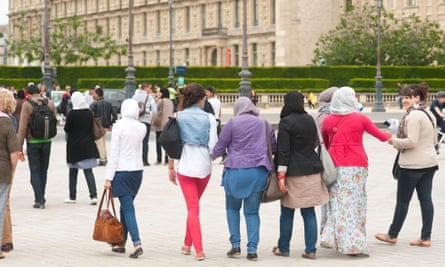In the early 2000s, I decided to commit to feminism, so I joined a feminist campaigning group, convinced I had found an organisation that would defend the rights of every woman equally. At the time, a national debate was raging: in the name of laïcité – or secularism – France was questioning Muslim schoolgirls’ right to wear head coverings in secular state schools. In March 2004, after months of debate, the French parliament voted through a ban on headscarves in schools, outlawing “symbols or clothing that conspicuously demonstrate a pupil’s religious affiliation”.
That is when I realised that the decision was quite popular in feminist circles, including the predominantly white group I was part of. Many white feminists thought it was their mission to help emancipate Muslim women and girls from a particular type of patriarchy tied to Islam. I quit the group. If Muslim women were enduring a specific form of patriarchal oppression, and really had no agency or free will when it came to wearing the hijab – a view I don’t share – how would it help them to exclude them from schools and access to emancipatory knowledge?
To me, the preoccupation with the hijab seemed to be a condescending way of singling out a mainly non-white group of females as if they were not affected by the same forms of patriarchy as other women. I took the view that we had to listen to what women and girls wanted for themselves before explaining their experience through the lens of cultural domination.
The 1905 law that first established the principle of laïcité in France was about guaranteeing freedom. It instituted the separation of church and state, the free exercise of religion by French citizens , and respect for all citizens before the law, regardless of belief. Secularism imposed neutrality on the French state and on public institutions, but did not require personal neutrality from citizens.
But 2004 marked a significant shift in the understanding of the secularism principle, by requiring users of state schools to be neutral about religion, or at least discreet about their beliefs. Education was the only public service to which the 2004 rule applied.
In a post-9/11 context of rising Islamophobia, the idea that Muslims’ visibility had to be kept in check had entered mainstream French opinion, the media and the political class. Students ought to have been protected by the public educational establishments they were attending, no matter how they chose to present themselves. But the principle of laïcité had evolved to include the demand that individuals make their faith an entirely private matter.

While the 2004 law was framed as a ban on all “conspicuous” religious symbols, including large Christian crosses, in practice it was targeted at expressions of Islam. As such, it has, over the past 20 years, opened the door to the pursuit of an unrelenting Islamophobia, embodied in a fixation on Muslim women and girls’ appearance.
In 2023 the Macron government added a ban on the abaya (a long-sleeved dress of Middle Eastern origin) in state schools, without defining it, which has left a lot of scope for schools to make arbitrary rulings. Telling the difference between a long dress and an abaya is simply not possible. Many Muslim girls and women cover themselves with dresses sold in regular retail stores. So the same outfit can be deemed religious on a supposedly Muslim girl, but acceptably neutral if worn by a non-Muslim. What is this if not racial profiling?
Beyond schools, in 2011 it became illegal for anyone to cover their face in a public place, a measure seen as targeting Muslim burqas. In 2016 municipalities began to ban burkinis from public pools and beaches. An attempt to overturn that rule was struck down in the courts in 2022.
Hijab-wearing female athletes meanwhile, have been excluded from teams, banned from practising their sport, even from the 2024 Paris Olympics. Ironically, while French athletes will not be able to wear a hijab in their own country, International Olympic Committee rules will allow women from other countries to compete in hijabs.
Privately-owned businesses are not, like the public sector, bound by secularism rules. But such is the confusion that many act as if they are, as a controversy which blew up this week over the treatment of a hijab-wearing temporary employee at a shoe store in Strasbourg demonstrated. Laïcité, conceived to protect freedom, has become a tool for harassment, humiliation and exclusion.
Such patronising of women of colour and their supposed “submission” can be traced to the French colonial era. Public unveiling ceremonies of colonised Algerian women were organised by the military in the 1950s to promote “assimilation” and even “civilization”. Unveiling the women was a way of asserting control over both the colony and the bodies of the colonised people.
In the post-#MeToo era, measures that encroach upon women’s bodily autonomy warrant unequivocal condemnation. Women should be free to choose how they present their bodies, whether they opt to cover them up or not.
But the desire to track markers of religiosity reflects an intolerance of Muslims that goes beyond the targeting of women. Beards have been challenged, and a Muslim man had his application to join the police rejected because of his tabâa (a mark on the forehead from the regular practice of prayer). More recently, the French football federation ruled that players on the national team are no longer allowed to fast during Ramadan.
after newsletter promotion

The message to all Muslims is clear: assimilate or stay out of the public sphere. It is no great surprise that an increasing number of Muslim individuals are voting with their feet and opting to leave France.
The principal of a high school in Paris quit the job recently after receiving online death threats following an altercation with a student who had been asked to remove her veil. The student, who was over 18, countered with an accusation of physical assault, which prosecutors dismissed. The prime minister Gabriel Attal then intervened to say the state would sue the student for falsely accusing the head teacher of mistreatment.
It is an indictment of the headscarf ban and the wider intolerance of Muslim dress it ushered in, that 20 years on, schools are still struggling with enforcement. The measure is perceived as discriminatory by many Muslims, and repeatedly fuels tensions to the point of necessitating government intervention. Even on its own terms, it is a blatant failure.
The positive news is that Muslims, and especially Muslim women, have, in the past 20 years found their own ways to resist, creating organisations such as Lallab, which challenges narratives about Muslim women; Mamans Toutes Egales (Mums Are All Equal) which supports hijab-wearing mothers to be involved in their children’s school lives; and Les hijabeuses, a hijab-wearing women’s soccer team.
Luckily, younger generations tend to reject the way that the principle of laïcité has been perverted. Let us hope they can build a future that is inclusive and welcoming for every citizen – whatever they choose to place on their heads. Only when this is achieved will we have an authentically secular French state and a free society.
Rokhaya Diallo is a French journalist, writer, film-maker and activist. She is a Guardian Europe columnist
Do you have an opinion on the issues raised in this article? If you would like to submit a response of up to 300 words by email to be considered for publication in our letters section, please click here.

